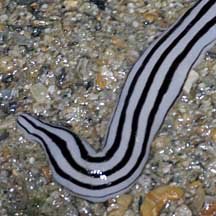
You might be wondering why ribbon worms matter in tide pools. Besides their intriguing appearance, they play essential roles in the marine ecosystem. Understanding what to look for when spotting ribbon worms can enhance your tide pool explorations and deepen your appreciation for marine biology. So, grab your sandals, and let’s dive into the captivating world of ribbon worms!
What Are Ribbon Worms?
Ribbon worms belong to a group called **Nemertea**, which sounds fancy but is quite simple when you break it down. These creatures have soft, elongated bodies that can stretch up to several meters in length, although most you’ll encounter are much shorter. Their bodies are typically brightly colored or patterned, ranging from vibrant oranges and pinks to muted browns and greens.
One of the most remarkable features of ribbon worms is their **proboscis**. This is a long, tubular structure they can extend to capture prey. Think of it like a tongue but much more versatile. They use it to snatch up small fish, crustaceans, and even other worms! So, when you see a ribbon worm, remember it’s not just a pretty face – it’s a skilled predator in its own right.
Where to Find Ribbon Worms in Tide Pools
Finding ribbon worms can sometimes feel like a treasure hunt. You’ll usually spot them hiding under rocks or nestled in the sand. They prefer areas where the water is brackish, which means it’s a mix of salt and fresh water. So, look for tide pools that are closer to estuaries or river mouths.
When the tide is low, the water recedes, leaving behind pools that are perfect for exploration. Here’s what to do:
- Carefully lift rocks: Ribbon worms often hide underneath them. Just be gentle—there might be other critters living there!
- Observe sandy areas: They can sometimes be buried just beneath the surface. A little digging with your fingers can reveal hidden treasures.
- Check out seaweed: Ribbon worms sometimes wrap themselves around seaweed for camouflage, making them even harder to spot.
Being patient and observant will go a long way in ensuring a successful ribbon worm search.
Identifying Ribbon Worms
Once you’re peering into a tide pool and you think you’ve spotted a ribbon worm, how can you be sure? Here are some tips on identifying these unique creatures:
Length: Ribbon worms can be quite long, but most are slender and can be just a few inches to a few feet long, depending on the species.
Color: Their bright colors are a giveaway. Many ribbon worms have striking patterns or can even change color depending on their environment. This adaptive trait helps them blend into their surroundings.
Movement: Watch for how they move. Ribbon worms glide smoothly through the water, often extending their bodies in a fascinating, wave-like fashion. If you see a worm whipping out its proboscis, you’re definitely looking at a ribbon worm!
With these characteristics, you’ll be able to spot these intriguing creatures with ease.
The Role of Ribbon Worms in the Ecosystem
You might not think of worms as important, but ribbon worms play a significant role in their ecosystems. As predators, they help control the populations of smaller marine animals, like snails and other worms. This predation keeps the balance in tide pools, ensuring that no single species dominates the environment.
Additionally, ribbon worms are a food source for larger animals, including birds and fish. When they thrive in tide pools, they’re contributing to the greater marine food web, showcasing just how interconnected all ocean life is.
By observing ribbon worms in their natural habitat, you’ll gain insights into the delicate balance of marine ecosystems and the importance of every creature, no matter how small.
Caring for Tide Pools and Ribbon Worms
As you get excited to explore tide pools and meet ribbon worms, it’s vital to remember to **respect these environments**. Here are some tips for responsible tide pooling:
- Don’t disturb: Be mindful when lifting rocks and avoid removing any creatures from their homes. Remember, they live here!
- Leave no trace: Take only photos and memories; leave the tide pools as you found them.
- Educate others: Share your knowledge about ribbon worms and the importance of tide pools with friends and family. The more we understand, the more we can protect these habitats.
Tide pooling can be a magical experience, but it comes with a responsibility to the creatures that call it home.
Fun Facts About Ribbon Worms
Here are a few fun tidbits that might surprise you about ribbon worms:
- Regeneration: If a ribbon worm gets cut in half, it can regenerate its missing parts! Yes, you read that right – nature has some seriously cool tricks.
- Variety: There are over a thousand species of ribbon worms, and they can be found in oceans around the world, demonstrating their adaptability.
- Color changes: Some species can change colors, just like a chameleon! This is primarily for camouflage and communication.
These facts not only make ribbon worms intriguing but also highlight the wonders of marine life.
Exploring tide pools and looking for ribbon worms is an adventure filled with discovery and wonder. With their vibrant colors, fascinating movements, and unique roles in the ecosystem, ribbon worms are a highlight of any seaside excursion.
Remember to approach your tide pool adventure with curiosity and respect. By understanding more about these creatures and their habitats, you not only enrich your experience but also contribute to the ongoing conversation about marine conservation. So, the next time you visit a tide pool, keep your eyes peeled for these sleek sea ninjas, and enjoy every moment of your journey into the vibrant world beneath the waves!
